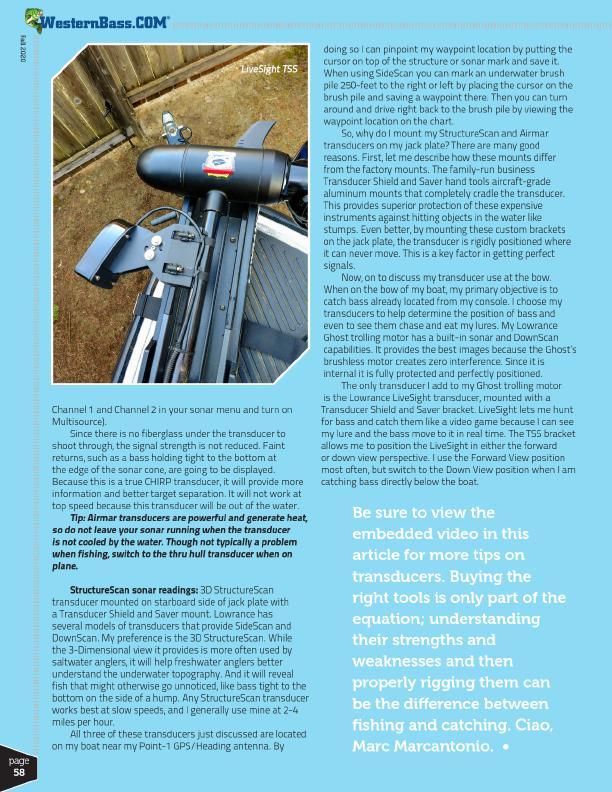
®
Fall 2020
page 58
LiveSight TSS
Channel 1 and Channel 2 in your sonar menu and turn on Multisource).
Since there is no fiberglass under the transducer to shoot through, the signal strength is not reduced. Faint returns, such as a bass holding tight to the bottom at the edge of the sonar cone, are going to be displayed. Because this is a true CHIRP transducer, it will provide more information and better target separation. It will not work at top speed because this transducer will be out of the water.
Tip: Airmar transducers are powerful and generate heat, so do not leave your sonar running when the transducer is not cooled by the water. Though not typically a problem when fishing, switch to the thru hull transducer when on plane.
StructureScan sonar readings: 3D StructureScan transducer mounted on starboard side of jack plate with a Transducer Shield and Saver mount. Lowrance has several models of transducers that provide SideScan and DownScan. My preference is the 3D StructureScan. While the 3-Dimensional view it provides is more often used by saltwater anglers, it will help freshwater anglers better understand the underwater topography. And it will reveal fish that might otherwise go unnoticed, like bass tight to the bottom on the side of a hump. Any StructureScan transducer works best at slow speeds, and I generally use mine at 2-4 miles per hour.
All three of these transducers just discussed are located on my boat near my Point-1 GPS/Heading antenna. By
doing so I can pinpoint my waypoint location by putting the cursor on top of the structure or sonar mark and save it. When using SideScan you can mark an underwater brush pile 250-feet to the right or left by placing the cursor on the brush pile and saving a waypoint there. Then you can turn around and drive right back to the brush pile by viewing the waypoint location on the chart.
So, why do I mount my StructureScan and Airmar transducers on my jack plate? There are many good reasons. First, let me describe how these mounts differ from the factory mounts. The family-run business Transducer Shield and Saver hand tools aircraft-grade aluminum mounts that completely cradle the transducer. This provides superior protection of these expensive instruments against hitting objects in the water like stumps. Even better, by mounting these custom brackets on the jack plate, the transducer is rigidly positioned where it can never move. This is a key factor in getting perfect signals.
Now, on to discuss my transducer use at the bow. When on the bow of my boat, my primary objective is to catch bass already located from my console. I choose my transducers to help determine the position of bass and even to see them chase and eat my lures. My Lowrance Ghost trolling motor has a built-in sonar and DownScan capabilities. It provides the best images because the Ghost’s brushless motor creates zero interference. Since it is internal it is fully protected and perfectly positioned.
The only transducer I add to my Ghost trolling motor is the Lowrance LiveSight transducer, mounted with a Transducer Shield and Saver bracket. LiveSight lets me hunt for bass and catch them like a video game because I can see my lure and the bass move to it in real time. The TSS bracket allows me to position the LiveSight in either the forward or down view perspective. I use the Forward View position most often, but switch to the Down View position when I am catching bass directly below the boat.
Be sure to view the embedded video in this article for more tips on transducers. Buying the right tools is only part of the equation; understanding their strengths and weaknesses and then properly rigging them can be the difference between fishing and catching. Ciao, Marc Marcantonio. •